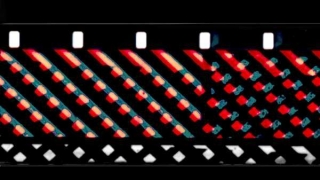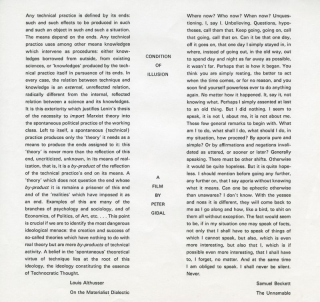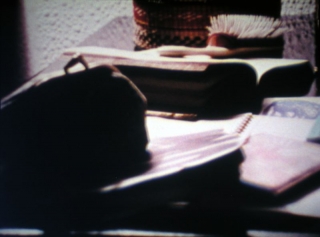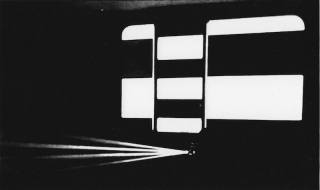Date: 20 October 2016 | Season: Shoot Shoot Shoot 2016 | Tags: Shoot Shoot Shoot
SHOOT SHOOT SHOOT PROGRAM 1
Thursday 20 October 2016, at 7:30pm
New York Anthology Film Archives
It was the film workshop that set the structure of the LFMC apart from other film co-ops. The facility housed a continuous processor and step printer that enabled filmmakers to work directly with the medium, without the need or expense of commercial laboratories, and provided a set of technical parameters that enabled a school of filmmaking to develop. This program spotlights works that were, more or less, produced within that environment, from the more playful films of Annabel Nicolson and Marilyn Halford, to one of Malcolm Le Grice’s early loop-based found footage meditations on the military/industrial complex. Mike Leggett’s seminal process-piece Shepherd’s Bush, a measured passage from darkness to light, was conceived as a test for the Co-op’s step printer but is nonetheless a cathartic experience for the viewer. Chris Garratt’s Versailles I & II and Lis Rhodes’ dynamic Dresden Dynamo explore the possibilities of using visual imagery to create optical sound on 16mm film.
Annabel Nicolson, Frames, 1973, 16mm, 18fps, color, silent, 8 min
Marilyn Halford, Footsteps, 1975, 16mm, b/w, sound, 7 min
Mike Leggett, Shepherd’s Bush, 1971, 16mm, b/w, sound, 15 min
David Crosswaite, Film No. 1, 1971, 16mm, color, sound, 10 min
Lis Rhodes, Dresden Dynamo, 1971-72, 16mm, color, sound, 4 min
Chris Garratt, Versailles I & II, 1976, 16mm, b/w, sound, 11m
Malcolm Le Grice, Reign of the Vampire, 1970, 16mm, b/w, sound, 16 min
Date: 23 October 2016 | Season: Peter Gidal: Flare Out
PETER GIDAL: FLARE OUT
23—24 October 2016
New York Anthology Film Archives
“He draws out singularities. He allows the camera only a fenced in area, piecemeal. He lets the gaze hold on objects and constantly repeats … this permits the possibilities of the discrepancies between one’s own seeing and seeing with the camera to become distinct, and this in turn allows for a completely different experience of the surroundings.” (Birgit Hein)
For five decades, Peter Gidal has sought to problematize the film-viewing process by creating works that resist recognition and identification. His practice posits film as a durational experience and negates analysis on psychological grounds. These two programs survey his radical approach, ranging from the seminal early works Hall and Clouds (1969) to the recent Coda I, Coda II and not far at all (2013).
Gidal has lived in the UK since the late 1960s and was a central figure during the formative years of the London Film-Makers’ Co-operative. He is a noted writer and polemicist, whose “Theory and Definition of Structural/Materialist Film” is a key text of avant-garde cinema.
Following the recent publication of a collection of Gidal’s essays, Jonathan Rosenbaum commented: “The singular way that Peter Gidal wrestles with language is a continual lesson in philosophy, aesthetics, ideology, and politics. Flare Out: Aesthetics 1966–2016 charts his ongoing struggles with wit, lucidity, and genuine brio.”
Flare Out: Aesthetics 1966–2016, edited by Mark Webber and Peter Gidal, is published by The Visible Press. In addition to many texts relating to film, it also includes essays on the work of Samuel Beckett, Thérèse Oulton, Gerhard Richter and Andy Warhol.
Date: 24 October 2016 | Season: Peter Gidal: Flare Out
PETER GIDAL: FLARE OUT PROGRAM 2
Monday 24 October 2016, at 7pm
New York Anthology Film Archives
“Mental activation toward material analysis is the process that is relevant, whether or not actual structure is ‘revealed’.” (Peter Gidal, 1969)
Clouds was the first real manifestation of Gidal’s anti-illusionist project, a film in which “There is virtually nothing on screen, in the sense of in screen. Obsessive repetition as materialist practice not psychoanalytical indulgence.” Assumption is, by stark contrast, exhilarating viewing. One of the densest minutes of all cinema, the screen bristles with recognizable images, fleeting texts and snatches of dialogue in tribute to filmmaker/activist Mary Pat Leece. Silent Partner and Epilogue return to the more familiar territory of domestic interiors, inhabited spaces interrogated by a restless camera. Anti-narrative, against representation, militant and uncompromising, yet despite themselves, strangely compelling. After a hiatus from filmmaking, Gidal returned in 2013 with not far at all: “tempted to say different yet the same, but not.” The film was awarded the L’age d’or Prize at the Brussels Cinematek in 2015.
Peter Gidal, Assumption, 1997, 16mm, color, sound, 1 min
Peter Gidal, Clouds, 1969, 16mm, color, sound, 10 min
Peter Gidal, Silent Partner, 1977, 16mm, color, sound, 35 min
Peter Gidal, Epilogue, 1978, 16mm, color, silent, 7 min
Peter Gidal, not far at all, 2013, 16mm, color, sound, 15 min
Date: 4 November 2016 | Season: Shoot Shoot Shoot 2016 | Tags: Shoot Shoot Shoot
SHOOT SHOOT SHOOT: THE LONDON FILM-MAKERS’ CO-OP
Friday 4 November 2016, at 7pm
Cambridge Harvard Film Archive
To celebrate the 50th anniversary of the London Film-Makers’ Co-operative, this screening presents a selection of work by some of innovative film artists that gathered there in its formative years: David Crosswaite, Marilyn Halford, Malcolm Le Grice, Mike Leggett, Annabel Nicolson, William Raban, Lis Rhodes and John Smith.
Inspired by the example set by Jonas Mekas and his colleagues in New York, the London Co-op was founded in 1966. In contrast to similar organizations, the LFMC’s activity was not limited to distribution – within a few years it was running a regular program in its own cinema and, most notably, had a workshop in which filmmakers could control every stage of the creative process.
The workshop housed a continuous processor and step printer and was an essential, contributory factor in steering the direction of the uncompromising films produced at the LFMC in the 1970s. The tendency was defined by as ‘structural/materialist’ by one of the group’s leading polemicists, Peter Gidal, alluding to what was then the dominant mode in avant-garde cinema but adding a qualification that suggests both Marxist philosophy and the physical presence of the medium that was foregrounded in British filmmaking.
A second, and equally significant form of practice was expanded cinema, which made creative use of the mechanics of projection in the presentation of multi-screen films and performance works. Light Music by Lis Rhodes is exemplary in this regard. Two projectors face each other across the room, creating an environment in which the audience is participant. Its abstract imagery (an ever-changing array of horizontal lines composed as a musical score) is printed across the frame and optical soundtrack area of a 16mm film print, enabling it to be both seen and heard.
The program will be introduced by Mark Webber, author of Shoot Shoot Shoot: The First Decade of the London Film-Makers’ Co-operative 1966-76 (LUX, October 2016) and co-editor of Flare Out: Aesthetics 1966–2016, a collection of essays by Peter Gidal issued by The Visible Press in April 2016.
Annabel Nicolson, Frames, 1973, 18fps, color, silent, 8 min
Marilyn Halford, Footsteps, 1975, b/w, sound, 7 min
Mike Leggett, Shepherd’s Bush, 1971, b/w, sound, 15 min
David Crosswaite, Film No. 1, 1971, color, sound, 10 min
John Smith, Associations, 1975, color, sound, 7 min
William Raban, Broadwalk, 1972, color, sound, 12 min
Malcolm Le Grice, Reign of the Vampire, 1970, b/w, sound, 16 min
Lis Rhodes, Light Music, 1975, 2 screen, b/w, sound, 20 min
Following the screening in the HFA Cinematheque, the special presentation of Lis Rhodes’ Light Music will take place in the undercroft of the Le Corbusier designed Carpenter Center.
PROGRAMME NOTES
SHOOT SHOOT SHOOT: THE LONDON FILM-MAKERS’ CO-OP
Friday 4 November 2016, at 7pm
Cambridge Harvard Film Archive
FRAMES
Annabel Nicolson, UK, 1973, 16mm, 18fps, color, silent, 8 min
“The original was standard 8mm material that I’d shot in a village in Italy. The material had gone through a process of deterioration. I’d used it in performing and taken it through an old Russian slide projector. I took the lens out of this projector so I could pull the film strip through it, and that meant the image could be focused on different surfaces. Instead of the image falling onto a screen I could direct it around the room with the lens in my hand. In the process it got very torn and scratched and it was that material I eventually put in the contact printer and made into the 16mm film Frames.” (Annabel Nicolson)
FOOTSTEPS
Marilyn Halford, UK, 1975, 16mm, b/w, sound, 6 min
“Footsteps is in the manner of a game re-enacted, the game in making was between the camera and actor, the actor and cameraman, and one hundred feet of film. The film became expanded into positive and negative to change balances within it; black for perspective, then black to shadow the screen and make paradoxes with the idea of acting, and the act of seeing the screen. The music sets a mood then turns a space, remembers the positive then silences the flatness of the negative.” (Marilyn Halford)
SHEPHERDS BUSH
Mike Leggett, UK, 1971, 16mm, b/w, sound, 15 min
“Shepherd’s Bush was a revelation. It was both true film notion and demonstrated an ingenious association with the film-process. It is the procedure and conclusion of a piece of film logic using a brilliantly simple device; the manipulation of the light source in the Film Co-op printer such that a series of transformations are effected on a loop of film material. From the start Mike Leggett adopts a relational perspective according to which it is neither the elements or the emergent whole but the relations between the elements (transformations) that become primary through the use of logical procedure.” (Roger Hammond)
FILM NO. 1
David Crosswaite, UK, 1971, 16mm, b/w & color, sound, 10 min
“The systems of super-imposed loops are mathematically inter-related in a complex manner. The starting and cut off points for each loop are not clearly exposed, but through repetitions of sequences in different colors, in different ‘material’ realities (i.e. a negative, positive, bas-relief, neg-pos overlay) yet in constant rhythm (both visually and on the soundtrack hum) one is manipulated to attempt to work out the system structure … The film deals with permutations of material, in a prescribed manner but one by no means ‘necessary’ or logical (except within the film’s own constructed system/serial).” (Peter Gidal)
ASSOCIATIONS
John Smith, UK, 1975, 16mm, color, sound, 7 min
“Images from magazines and color supplements accompany a spoken text taken from Word Associations and Linguistic Theory by the American psycholinguist Herbert H Clark. By using the ambiguities inherent in the English language, Associations sets language against itself. Image and word work together/against each other to destroy/create meaning.” (John Smith)
BROADWALK
William Raban, UK, 1972, 16mm, color, sound, 12 min
“Originally, this was a four-minute time-lapse film which was shot continuously over a twenty-four hour period. The camera was positioned on a busy pathway in Regent’s Park, and recorded three frames a minute. The shutter was held open for the twenty-second duration between exposures, so that on projection, individual frames merge together making the patterned flows of human movement clearly perceptible. The time-lapse original was then expanded by various processes of re-filming to reveal the frame-by-frame structure of the original.” (William Raban)
REIGN OF THE VAMPIRE
Malcolm Le Grice, UK, 1970, 16mm, b/w, sound, 11 min
“This film could be considered as a synthesis of the ‘How to Screw the CIA’ series. It is formally based on the permutative loop structure, superimposing a series of three pairs of image loops of different lengths with each other. The images include elements from all the previous parts of the series. The film sequences which make up loops, are again chosen for their combination of semantic relationships, and abstract factors of movement. The soundtrack is constructed for the film, but independently, and has a similar loop structure.” (Malcolm Le Grice)
– intermission –
LIGHT MUSIC
Lis Rhodes, UK, 1975-77, 2 x 16mm, b/w, sound, 20 min
“The film is not complete as a totality; it could well be different and still achieve its purpose of exploring the possibilities of optical sound. It is as much about sound as it is about image; their relationship is necessarily dependent as the optical soundtrack ‘makes’ the music. It is the machinery itself which imposes this relationship. The image throughout is composed of straight lines. It need not have been.” (Lis Rhodes)
Back to top
Date: 15 January 2017 | Season: Shoot Shoot Shoot 2016 | Tags: Shoot Shoot Shoot
DAVID LARCHER: MARE’S TRAIL
Sunday 15 January 2017, at 7pm
London Close-Up Film Centre
One of the forgotten masterpieces of British avant-garde cinema. David Larcher’s epic film was assembled from quasi-autobiographical footage, shot over several years, that was processed, manipulated and edited into a dense, durational viewing experience. Generously employing assorted optical and aural trickery, Mare’s Tail unravels into a 2½ hour anarcho-mystical voyage of psychedelic revelation.
“From one flick of the mare’s tail came an unending stream of images out of which was crystallised the milky way.” (David Larcher)
Though made independently of the London Film-Makers’ Co-operative, the visual ingenuity and ambitious scope of Mare’s Tail made it a key contribution to the UK’s nascent experimental film scene. Containing footage that dates back to Larcher’s time as an RCA student in the mid-1960s, the film was completed some years later with funds provided by producer/patron Alan Power. It received its world premiere at the 1969 Edinburgh Film Festival and was the opening film for the IRAT Cinema at the Robert Street New Arts Lab.
David Larcher, Mare’s Tail, 1969, 16mm, colour, sound, 143 min
This rare 16mm screening is organised by LUX and Close Up to mark the publication of Shoot Shoot Shoot: The First Decade of the London Film-Makers’ Co-operative 1966-76, a compendium of texts, interviews, images and documents from the era.
PROGRAMME NOTES
DAVID LARCHER: MARE’S TRAIL
Sunday 15 January 2017, at 7pm
London Close-Up Film Centre
MARE’S TAIL
David Larcher, 1969, 16mm, colour, sound, 143 min
“Mare’s Tail is an epic flight into inner space. It is a 2 and 3/4 hour visual accumulation in colour, the filmmaker’s personal odyssey, which becomes the odyssey of each of us. It is a man’s life transposed into a visual realm, a realm of spirits and demons, which unravel as mystical totalities until reality fragments. Every movement begins a journey. There are spots before your eyes, as when you look at the sun that flames and burns. We look at distant moving forms and flash through them. We drift through suns; a piece of earth phases over the moon. A face, your face, his face, a face that looks and splits into shapes that form new shapes that we rediscover as tiny monolithic monuments. A profile as a full face. The moon again, the flesh, the child, the room and the waves become part of a hieroglyphic language …
Mare’s Tail is an important film because it expresses life. It follows Paul Klee’s idea that a visually expressive piece adds ‘more spirit to the seen’ and also ‘makes secret visions visible’. Like other serious films and works of art, it keeps on seeking and seeing, as the filmmaker does, as the artist does. It follows the transience of life and nature, studying things closely, moving into vast space, coming in close again. The course it follows is profoundly real and profoundly personal: Larcher’s trip becomes our trip to experience. It cannot be watched impatiently, with expectation; it is no good looking for generalization, condensation, complication or implication.”
—Stephen Dwoskin, Film Is: The International Free Cinema, 1975
Back to top




